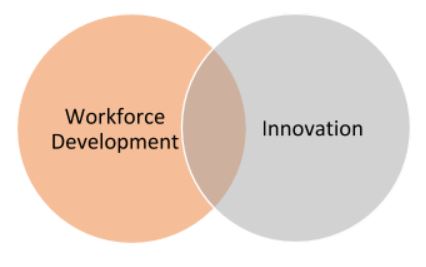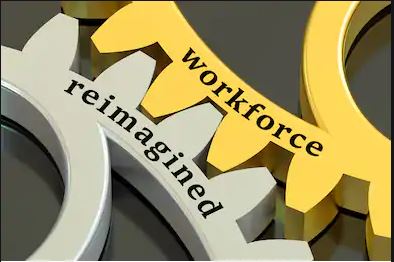This question – can we innovate workforce development in high school has been on my mind for quite some time.
The better question is why aren’t we doing a better job at it.
Everyone in business and education wants to find that silver bullet that innovates workforce development where it makes job preparation better, more aligned, and productive for current and future employees.
Equally important is how can we embed it in our schools, so graduates are more prepared rather than being overwhelmed going into a new position.
If you or I knew, we’d be learning a Noble Peace Prize and collecting a cool quarter of a million dollars by now.
What a lot of people in our society forget to realize is it affects our wallet. At the same time, it has a substantial influence on the tax base, the economy, and the infrastructure of the region.
You’d think that with the Billions of dollars invested in workforce development, the answer would appear right before our eyes.
But it hasn’t.
Many communities and companies continue to observe the same flatline results even though a great deal of time and effort was have been put into the goal.
In fact, when was the last time decision-makers looked for the answer from a different lens?
Tweet
What if leaders viewed this enigma from a whole different perspective?
What if I told you there’s a newer, more advanced way to address the workforce development dilemma, would you believe me?
Just indulge me for a few moments if you wouldn’t mind.
The first thing one must do is to compile the best practices in workforce development.
What are some of the Best InnovativeWorkforce Development Practices?
With great thought and investment placed on workforce development training and implementation, one would think that finding and retaining highly qualified employees would show a reduction in critical areas.
Studies and grants written for individual projects to develop workplace readiness have made the first steps towards the solution a success and critical pieces of information found to endeavor a success.
These identified areas where proved workforce strategies are shared amongst the industry are called best practices.
Thankfully there a few best practice reports compiled have helped thousands of localities.
Reports from the Camoin Associates and the U.S. Conference of Mayors Workforce Development Council have methodically shared some brilliant insight. These best practices reveal concepts such as creating a common baseline, vision alignment, being transparent, and coordinating with workforce development / economic development and schools.
Even with these practices utilized, more needs to be done at a level that raises the bar to a new and higher level of efficiency.
But it barely scrapes the surface of integrating these practices into STEM and Career Technical Education courses.
HUGE – HUGE MISTAKE!
Blending Innovation and Good Management In Today’s Businesses
Gary Hamel’s Future of Management book explains there are four types of Innovation: Operational Innovation, Product / Service Innovation, Strategic Innovation, and Management Innovation.
Each level has its purpose and uniqueness.
- Operational Innovation – where parts of the business can be outsourced, making it hard to defend from copying, and short-lived.
- Product / Service Innovation – comes next where the model still is easily duplicated.
- Strategy Innovation- becomes more difficult to copy due to the firm business model or strategy being tailored to the business’s strengths and weaknesses.
- Management Innovation – targets the elephant in the room with the capacity to deliver a near impossible solution to doable.
Management Innovation hinges on mobilizing talent, resources while building strategies into something new, exceptional, and revolutionary to the marketplace.
Aligning Best Practices and Innovation Together Into Our Public Schools
Observing these together has several benefits, as one would imagine. But consider fusing both Innovation and Best Practices into a more robust, more advanced Workforce Development program.
The results would be astounding.

Communities would have a unique model, specific to their locality, resources, and talent that carries a high impact and more substantial Return On Investment (ROI).
This new Workforce Development Program would entail three structures and within the structure, provide the blueprints to sustain a robust workforce.

Organization Structure
- Create a specific model designed to be flexible that utilizes real-time data
- Align stakeholders vision, terminology, and timelines where all benefit
- Identify short, mid and long-term obstacles and match them to the solutions to address them
- View Economic Development and Workforce Development as resources in the transition
Training and Teaching Structure
- Revamp ineffective training models
- Use two models for the current and future workforce
- Differentiate the teaching based upon the learning styles of the employees rather than making it a one-style presentation
- Insist on student-centered learning
- Arrange curriculum, so it scaffolds on skills needed at the, and it begins at the k-12 level and advances to the apprenticeships and internships.
- Verify that instructors can deliver the content and be subject matter experts. If the instructor is a one-trick pony, then employ a teacher who can engage the class.
- Know the skills needed for the future of work by having the instructors identify employee weaknesses before training
- Establish externships for k-12 teachers and mentoring for K-12 students
Communication and Marketing Structure
- Build a network for the region or company that fosters growth, creativity, and better alignment
- Market extensively. From recruiting to success stories, if the vision is unknown, no one will believe it much less buy into it
- Celebrate diversity which attracts more applicants and provides an influential culture
- Be clear, be concise and be consistent on the common goals
- Form satellite offices at K-12 schools, colleges and trade centers where professional development opportunities can be built and recruitment becomes easier
Einstein’s definition of insanity is doing the same thing repeatedly while expecting a different outcome. However, why do the same steps with workforce development, training, and engagement?
Branch out into the new era by taking a bold new approach to end the cycle of poverty and change diplomas to dollars.
The time is here.
The time is now.
Revolutionize the way we want tomorrow to become.
Do you want to stay current on workforce issues?
Need a different perspective when it comes to workplace readiness training?
Struggling with developing new and fresh ideas to enhance economic development?
Interested in developing and implementing transferable 21st Century skills that’s not covered in CTE and STEM Curriculum?
Having difficulty finding and retaining good talented employees?
Do you want to learn more about how can be on the cutting edge rather than following it?
Click here to schedule your own appointment
[wp-faq-schema title=”What are some other Workforce Development factors to consider?” accordion=1]


Leave a Reply
You must be logged in to post a comment.